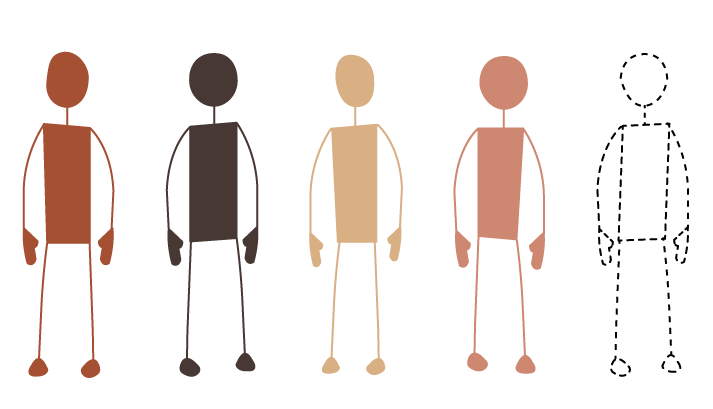Within the scope of the CitiObs project's focus on equality, diversity, and inclusion, Consortium Partner Andrea Reyes Elizondo investigates the complexities associated with the term "People of Colour".

Words are useful to communicate with each other. We use them to name objects, situations, and people that we think best describe them. However, words can have negative connotations of which we may be unaware of. This is especially the case when we use words to refer to groups of people.
At CitiObs we are working on several toolkits to aid citizen scientists work together with scientists, policy makers, and other citizen scientists to make healthy, sustainable, resilient, and inclusive cities. One of these toolkits focuses on equality, diversity, and inclusion. A core tenet of the project is the Leave No One Behind (LNOB) principle approved in 2015 by the 193 Member States of the United Nations. The goal of this LNOB toolkit is to ensure there is a diverse inclusion of citizens across gender, sociocultural condition, religious affiliation, literacy level, social status, and age. By ensuring that the various groups in a city or region are represented, citizen science can serve all communities.
Words matter
While working on the toolkit, we have sought to be mindful of the language that we use by considering how communities refer to themselves. One of the terms we assumed was correct was ‘People of Colour’ (POC). However, a colleague asked if the term was indeed the correct one. After all, white people also have colour and by using the term we risked reinforcing the idea that white is not a colour. Further, people of colour have been racialised as the others where white is seen as an implied standard. We asked ourselves if the various communities which can fall under the term ‘people of colour’ would use another term such as ‘racialised people’.
I took to task to find out which term was the correct one to use: ‘racialised people’ or ‘people of colour’. I asked colleagues from other citizen science projects around Europe, consulted three guides, an equity glossary, an academic paper tracing the history and usage of the term, and a sociology encyclopedia entry. Finally, I looked at a series of articles focused on inequality in the sciences, to see how people are described and how people describe themselves. Below are my findings and the sources consulted.
The history
The first step was to look at the history of the term. ‘People of colour’ evolved from the term ‘coloured people’ which was used to refer to free enslaved persons in the nineteenth century. The term has expanded to cover not only Blacks but also Latinos, Hispanic, Indigenous, and Asians, among others. Some activists and communities agree it can be problematic, as it implies Whites have no colour and is presented as an opposition of Whiteness. However, the racialisation of non-White peoples is a fact, thus the term serves to highlight the structural differences already present in societies.
The guidelines
According to our colleagues that work on empowerment, inclusiveness & equity at the European Citizen Science Association (ECSA), the term 'people of colour' is widely accepted and used by activists and communities, although there are some cases when it is better to use other terms. They suggested to double check some guides and glossaries to make sure we cover the nuances in our toolkit.
The guides and glossaries did confirm that ‘people of colour’ is an accepted term and is widely used by activists and communities. One exception is when referring to specific communities, in which case the name preferred by said community should be used, in accordance to the context where it is being used. For example, the term Indigenous can take different forms depending on the region. Another exception is to avoid using the term as coded language for sociocultural conditions such as ‘immigrant.’
One of the main concerns related to the use of ‘people of colour’, is that it can invisibilise specific groups, such as Native communities, or that it brushes away specific cases of discrimination, such as anti-Black racism. As a response, some activists and community managers prefer to use the term ‘Black, Indigenous, (and) People of Color’ (BIPOC).
While the term ‘people of colour’ may seem to erase differences between various communities by lumping everybody together, it is flexible enough to capture the diverse identities people can have. For example, I am a light-brown immigrant with two nationalities. In some places I pass as “white”, depending on the history of the place where I am and its relationship to my country of origin. Further, in my country of origin I am in a privileged position compared to Indigenous peoples. Nevertheless, I have experienced some structural barriers and discrimination due to my various backgrounds. In my case, the term ‘woman of colour’ covers this complex identity.

Andrea Reyes Elizondo, Leiden University
The practice
After looking at the background, I focused on practice: how is it used in news and articles both by people outside of these communities and people inside those communities? For this, I looked into a series of articles in Nature on inequality in the sciences: Decolonizing science toolkit (2023), Racism. Overcoming science’s toxic legacy (2022), and The rise of citational justice: how scholars are making references fairer (2022). When referring to a diverse group, the editors used ‘people of colour’, but when referring to specific groups they used the preferred terms from that community such as Black (capitalised). These were also the terms used by the people of colour cited in the articles: POC for a mixed group; specific term when appropriate.
In summary, the term ‘people of colour’ is accepted and widely used, even if there are some concerns around it. What is important is to always be clear on why some terms are chosen above others and the nuances in different languages. We also need to be aware of what is said vs. what is implied, and most importantly, that diverse communities are part of this conversation ensuring they are given a space for their voices. We cannot talk for other people, they can talk by themselves. We just need to listen.
Sources consulted
A Progressive’s Style Guide: Toward Harnessing Language in Support of Intersectionality and Cross-sector Power Building. Hanna Thomas (SumOfUs.org) and Anna Hirsch (ActivistEditor.com).
Creating Cultures and Practices for Racial Equity: A Toolbox for Advancing Racial Equity for Arts and Cultural Organizations. Nayantara Sen and Terry Keleher, Race Forward, 2021.
Racial Equity Tools Glossary. MP Associates, Center for Assessment and Policy Development, and World Trust Educational Services, July 2022.
Words Matter. An Unfinished Guide to word choices in the Cultural Sector. Compiled by the National Museum of World Cultures, the Netherlands. 2017.
Academic sources
Starr, P. (2023). The Re-Emergence of “People of Color.” Du Bois Review: Social Science Research on Race, 20(1), 1–20. https://doi.org/10.1017/S1742058X22000145
Vidal-Ortiz , S. (2008). People of color. In R.T. Schaefer (Ed.), Encyclopedia of Race, Ethnicity, and Society (Vol. 3, pp. 1038-1039). SAGE Publications, Inc., https://doi.org/10.4135/9781412963879


